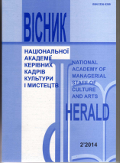MONUMENTAL HERITAGE OF VLADIMIR FEDKO AND ITS IMPACT ON THE ARTIST'S EASEL PAINTING
DOI:
https://doi.org/10.32461/2226-3209.2.2014.137979Keywords:
monumental art, mosaics, painting, composition, interpretation, pastiche, transformation, creativity, learning processAbstract
The article considers the career of the famous muralist painter, Honored Artist of Ukraine since1994, amember of theAcademyofArtsofUkrainesince 2001, member of the National Union of Artists, author of many tapestries, paintings and punches – Volodymyr Petrovych Fedko.
It is discovered the formation of the creative activity of the artist, the search of his own artistic ideal, which is based on respect for artists Boychuk and his school in conjunction with the aesthetics of Byzantine and Ukrainian art.
On the basis of these outstanding events of world culture it is revealed his own experience and his desire not to withdraw into his search, but to share it with others.
The article highlights the monumental heritage of the artist, who was active in the paintings of St. Michael's Cathedral inKiev, who is the author of political and cultural figures of Kievan Rus portraits gallery in the lobby of the metro station "Golden Gate" inKiev. The features of the Fedko’s creative method are identified, and the landmark stages of artistic and teaching activity are determined.
The topic of this article is discussed from the point of view of a unique Fedko’s approach to solving artistic image, its ability to styling, transformation and his peculiar world, which was formed under the influence of ethnic identity.
The article displays the understanding ofKievmonumental art of the second half of the twentieth century by the artist. Which in the present study confirms and defines a constant need for more careful study, so this topic is of particular relevance.
Special attention is paid to the analysis of exquisite mosaics of subway station "Golden Gate", which was opened inKievDecember 31, 1989. Mosaics on the station are considered one of the world's best works of monumental art created in the metro areas. Authors – Volodymyr Fedko and Gregory Koren have created the perception of a modern ensemble, which successfully woven into the historical fabric of the surrounding buildings. Mosaics of the twentieth century is associated with mosaics of St. Sophia and St. Michael cathedrals, but also on the structure of the composition, the nature of the figure, the soundness of all the elements of style and organization of color images are the works of the modern.
In addition to this, the author analyzes the works, which address the ideas of Christian asceticism and martyrdom, which become a major, and prompt the artist to philosophical speculation and artistic searching in the painting. The proof of that are the examples of paintings given by the author – "The Crucifixion" (1990), "Bright image" (1991), Triptych "The Crucifixion. Descent from the Cross" (1991), "Resurrection" (1994), "Trinity" (1999). These works are notable not only because of the subject, due to the author's desire to define the place of faith in the post-socialist society, but also due to the interpretation of the scenes.
We have identified a number of artistic mastery of line and attention to color, respectful observance of traditions and the ability to dive into the depths of the cultural heritage of the Ukrainian people. Thanks to it the artist spreads the idea of reviving the "Ukrainian-style", which at one time was actively introduced by B. Krichevsky, M. Boychuk and others artists, who were not indifferent to the fate of Ukrainian. The main achievement of the artist is the ability to think imaginatively, to be able to highlight the formal idea and subdue her creative solution design. In his opinion it is this ability gives the artist the freedom to determine their own creative abilities.
The author of this article reveals the mechanism of understanding the value of an artist interpretation and style, improvisation and transformation in the arts. And it explains the restructuring proposal of the educational process.
The article describes Fedko’s teaching activities, his ability to identify the main and accurately send the learning process. B. Fedko knew the need to learn to think, not discouraging, and instilling the respect for the achievements of artists of the past. And gradually develop the vision of the world, to teach students to boldly go by their own transformation.
Author proves a well-established system of perception of the world by the artist, which was built in the creative business for many years. B. Fedko, who had a sensitive personality and who always feel the ways to solve the problems of modern conceptual art, never imposed his own, the only true, idea to his followers and always gave students time to reflect on and make their own decisions. He was well aware of the way of the teacher, which stood by controlling the learning process, and sincerely sought to convey to students his own experience.
Downloads
Published
Issue
Section
License
Authors who publish with this journal agree to the following terms:
1. Authors retain copyright and grant the journal right of first publication with the work simultaneously licensed under a Creative Commons Attribution License International CC-BY that allows others to share the work with an acknowledgement of the work's authorship and initial publication in this journal.
2. Authors are able to enter into separate, additional contractual arrangements for the non-exclusive distribution of the journal's published version of the work (e.g., post it to an institutional repository or publish it in a book), with an acknowledgement of its initial publication in this journal.
3. Authors are permitted and encouraged to post their work online (e.g., in institutional repositories or on their website) prior to and during the submission process, as it can lead to productive exchanges, as well as earlier and greater citation of published work (See The Effect of Open Access).


